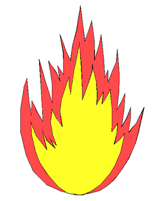Label Review Training: Module 3: Special Issues, Page 8
Section 2: How should I review precautionary statements?
Determining Physical or Chemical Hazards Statements
Flammable Products
Precautionary statements relating to product flammability are required if the product meets the criteria set out in the regulations and described in Chapter 9 of the Label Review Manual. Review Table 1 in that chapter to determine the appropriate flammability statements.
In order to avoid confusion, do not use the words “CAUTION,” “WARNING,” and “DANGER” with the flammability statements. These words are only to be used as the human hazard signal word on the product.
If the product is a total release fogger containing a propellant with a flash point at or below 20° F, the following label statement must be included in the physical or chemical hazards statement:
“This product contains a highly flammable ingredient. It may cause a fire or explosion if not used properly. Follow the Directions for Use on this label very carefully.”
In addition to this required language, a graphic symbol such as that illustrated below or an equivalent symbol must be displayed adjoining the physical or chemical hazards statement.

Ingrediente Altamente Inflamable
Declaration of Non-flammability
Certain products may bear a claim of non-flammability, with terms such as “non–flammable” or “non-flammable (gas, liquid, etc.).” The phrases “non–flammable,” “non–flammable gas,” or “non–flammable liquid,” may appear as a sub–statement to the ingredients statement, or on a back or side panel. The phrase should not be highlighted or emphasized such that they constitute a misleading safety claim. If “Extremely Flammable” or “Flammable” appear in the physical or chemical hazards statement, the claim of non–flammability cannot be used.
See Chapter 9, Section IV.B of the Label Review Manual to review the criteria for declaring non–flammability.
Labeling for Liquid Products Used Near Electrical Equipment
Some liquid products may pose a shock hazard when used near electrical equipment or outlets. The dielectric breakdown voltage—a measure of a liquid's capacity to conduct electricity—is required if the end–use product is a liquid and is to be used near electrical equipment.
If the product meets the criteria outlined in Chapter 9, Section V.A of the Label Review Manual, the following statement must appear in the physical or chemical hazards section:
“Do not apply this product around electrical equipment due to the possibility of shock hazard.”
Labeling for Explosive Potential
When data demonstrate hazards of a physical or chemical nature other than flammability (such as explosive potential), the label must include appropriate statements of hazard. Such statements must address the potential explosion hazard. Chemicals that EPA recommends have specific statements for potential explosion hazard include, but are not limited to: sulfur dust, carbon dust, potassium nitrate, sodium nitrate, and potassium chlorate.
Other Physical or Chemical Hazards
Chapter 9 of the Label Review Manual provides additional information regarding physical or chemical hazards associated with certain fumigant chemicals, mixing certain products, and use of fire retardant.
When data demonstrate hazards of a physical or chemical nature other than flammability or explosive potential, appropriate statements of hazard must be included on the label. Such statements may address hazards of oxidizing or reducing capability, reactivity, or corrosivity. These decisions are made on case–by–case basis.
Resource
To determine physical or chemical hazards statements, see Chapter 9 of the Label Review Manual.
Page 8 of 43
Previous Page Next Page
